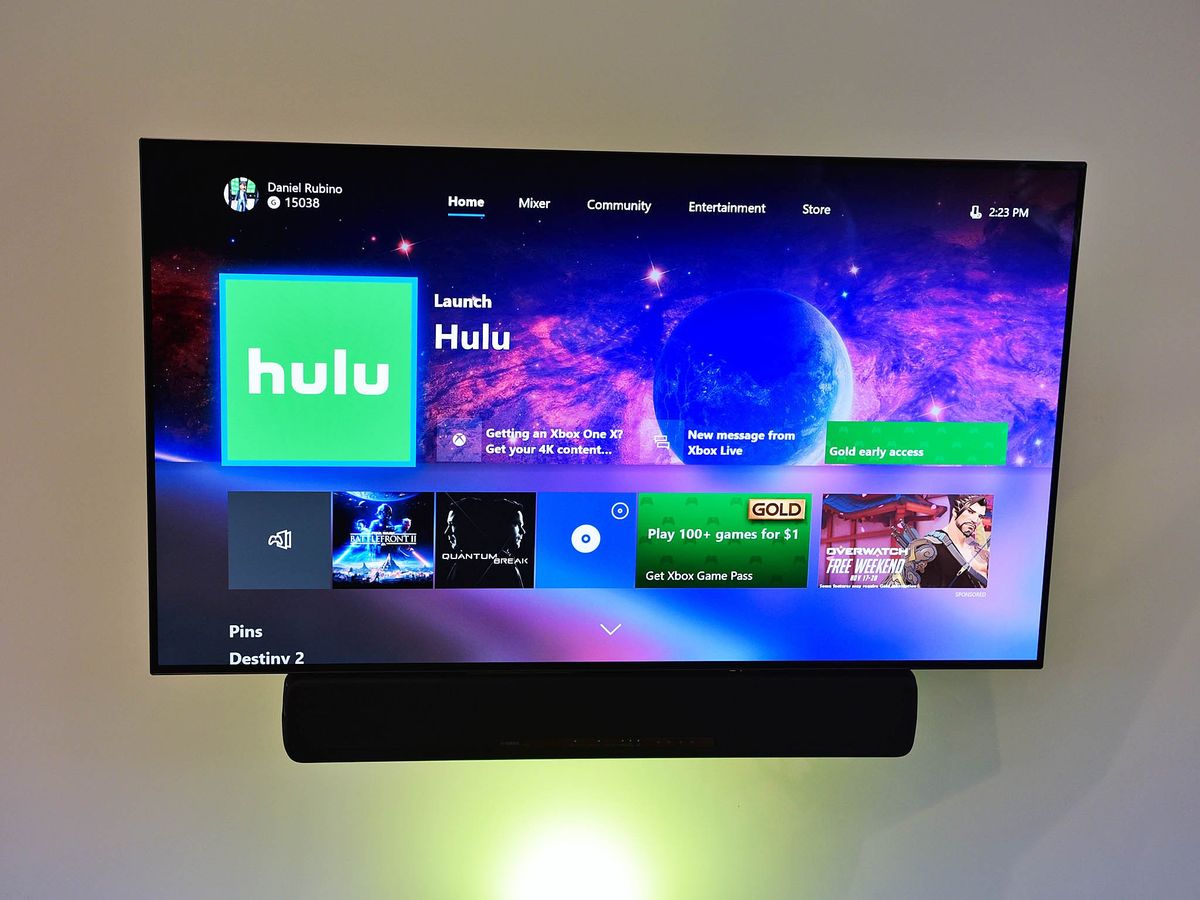Earlier in August, I reviewed the Xbox One S wall mount from HIDEit – a sleek metal custom mount that lets you place the console behind your wall mounted TV. The HIDEit mount is perfect for those who don't want to purchase and install a wall shelving system, or just to keep their wall-mounted TV clean and minimalist.
With the new Microsoft Xbox One X hitting store shelves HIDEit is back with is a new mount for that console. I recently installed it and here is what I think.
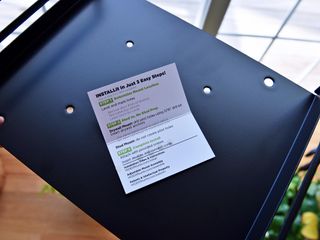
About this review
HIDEit notified back in August that the One X would also get its own mount and sent me one as soon as it was ready. The company is now selling them directly on its website or through Amazon with free Prime shipping. The retail price is $44.99 on Amazon, but HIDEit sells it directly sometimes as low as $35.99.
What this is and who it's for
With the Xbox One X and like other gaming consoles where you put it matters. Many people have larger entertainment centers, but with wall mounts costing between $15 and $45, it's often cheaper to just put a new, thin high-end TV directly on the wall. The problem arises of how to use a gaming console in a such a setup.

HIDEit makes many types of mounts meant to be placed behind the TV (or just on the wall, adjacent) keeping the electronics out of the way and discreet. There are even universal mounts letting users, and handy creative types set up PCs and other forms of displays in their house of a custom look.
The HIDEit Xbox One X mount is a simple, all steel frame with screws that drill into your drywall. Included drywall anchors ensure that the screws never come loose.
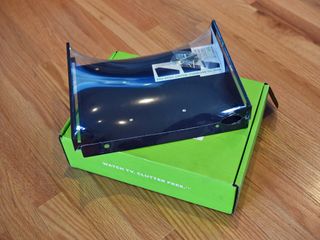
Here is what is included in the box for the Xbox One X HIDEit mount:
- VESA Compatible: 100mm (M4) & 200mm (M4/M6)
- Easy access to power button, output jacks, and cables.
- Cold-rolled 16-gauge Steel for superior strength.
- Powder coat finish protects from scratches.
- Made in the USA from Recycled & Imported Steel.
- Quick and easy to assemble and install. No measuring, no templates.
The package arrived with the mount itself wrapped in shrink plastic for protection. Screws, anchors, directions, were all included. The only thing you need for installation is a drill (3/16 for the drill bit and anchors) and a screwdriver. The screws are not unusually long, and there are only four, so you can even do this all by hand without a drill.
Installation is a no-brainer
For my setup, I have a 55-inch LG OLED TV already mounted on the wall. In this case, I am removing the existing One S HIDEit mount and replacing it with the One X version. Due to the similar setup, I could just re-use the existing holes, but since I also swapped out the TV (Samsung to an LG) the TV is now slightly higher due to a different mounting bracket, so I'll be moving the HIDEit mount up marginally higher too.
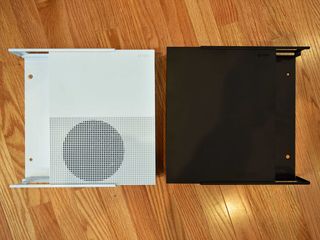
Installation takes only about 15 minutes. Just line up the mount on the wall behind the TV, mark the four inner holes (if not using a VESA setup), drill, add anchors and then secure the mount to the wall.
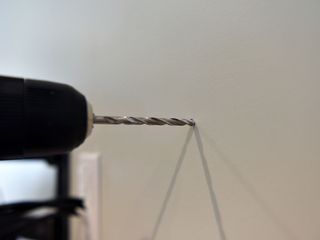
Due to the size of the TV, the HIDEit mount can easily fit behind it and still be invisible from view. Smaller TVs including 32" ones may be a tighter squeeze but should still work.
Best 4K HDR TV for Xbox One X and Xbox One S
You'll, of course, want to do a dry run because the One X is asymmetrical, and so is the mount. Which way you want it facing and how it slides in (it's only one way) depends on which end you mount up. Since I wanted the One X is to push right to left the mount is placed with the logo upside down this way the Xbox power button is facing rightwards behind the TV.
Once the mount is screwed in, the One X just slides in. There is no set screw to keep locked in, but unless there is a severe earthquake, there is little chance that the One X can slide back out. Afterwards, just connect your cables to the back of the TV, and you are all set.
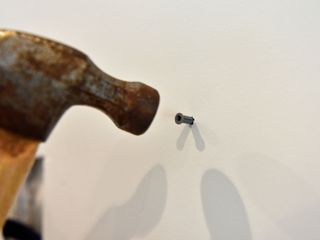
Since the One X cools by bringing air in from the sides and pushing it out of the back, the HIDEit mount never interferes with the process, ensuring you won't damage the One X from overheating.
And for those wanting not to hide their One X console you can just as quickly place the mount adjacent to the TV, letting you show off your limited-edition "Project Scorpio" console if you have one (I'll be doing that for the downstairs).
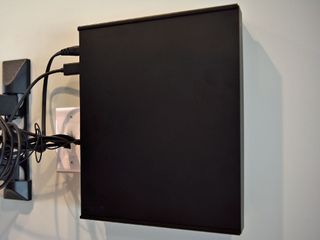
Finally, the One X mounted behind the TV works just fine with the standard Xbox wireless controllers and the PDP Talon media remote, which I still highly recommend. I experienced no degradation in performance with the Talon PDP remote and didn't feel I had to do any awkward angles to get it to work, which is a testament to how good that $20 remote is and why you should still get one.
HIDEit mounts still highly recommended
For those looking for a clean and sleek setup, there's still nothing quite like HIDEit mounts. The quality of the mount is excellent with no creaks, or bendable areas and being made in the U.S. helps. Installation is super simple even if you're not power tool savvy – it's four holes, and you're done.
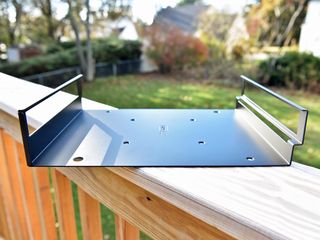
As of now, HIDEit is not selling the One X kit with additional mounts for your Xbox controllers (which you can see in my photos), but you can purchase those separate for $16 (two-pack) and even get a headset mount for your gaming headphones to complete the set.
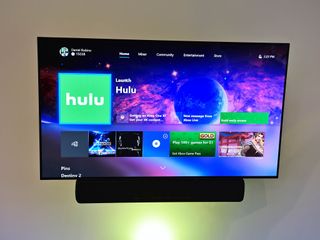
At just $45 the HIDEit Xbox One X mount seems like a no-brainer. The quality is excellent, installation is simple, and if you're thinking of keeping your Xbox One X off the table and the HIDEit mount will let you do some really creative stuff in your living room.
Pros:
- A fun way to show off your Xbox One X or completely hide it.
- Excellent build quality.
- Reasonable asking price.
- Easy installation.
Cons:
- Set-screw would have been nice.

Daniel Rubino is the Editor-in-chief of Windows Central. He is also the head reviewer, podcast co-host, and analyst. He has been covering Microsoft since 2007 when this site was called WMExperts (and later Windows Phone Central). His interests include Windows, laptops, next-gen computing, and wearable tech. He has reviewed laptops for over 10 years and is particularly fond of 2-in-1 convertibles, Arm64 processors, new form factors, and thin-and-light PCs. Before all this tech stuff, he worked on a Ph.D. in linguistics, performed polysomnographs in NYC, and was a motion-picture operator for 17 years.
